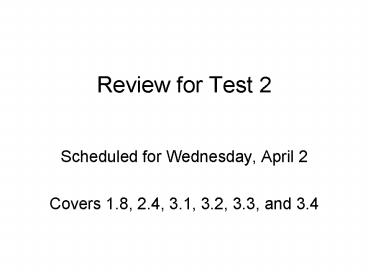Review for Test 2 - PowerPoint PPT Presentation
1 / 6
Title:
Review for Test 2
Description:
... does it mean for a set to be countable or uncountable How to prove a set is countable How to prove a set is uncountable Note the following theorem that we ... – PowerPoint PPT presentation
Number of Views:76
Avg rating:3.0/5.0
Title: Review for Test 2
1
Review for Test 2
- Scheduled for Wednesday, April 2
- Covers 1.8, 2.4, 3.1, 3.2, 3.3, and 3.4
2
Formal Framework for Induction
- You are asked to prove some statement X for all n
? S. - The set S is some well-ordered subset of the
integers of the form b, b 1, b 2, where
b is an integer. - The statement X is always some predicate
involving n, such as 1 2 n n(n 1) /
2. - 1st step Introduce your predicate.
- ex Let P(n) denote 1 2 n n(n 1) /
2. - Now you desire to prove ?n ? S P(n). And the
principle of mathematical induction tells you
that you can do this by showing both P(b) and
also ?n ? S P(n) ? P(n 1).
3
- 2nd step Prove base case Prove P(b)
- 3rd step Prove inductive case ?n ? S P(n) ?
P(n 1) - (a) Set up for universal generalization Let n
? S - (b) Assume the hypothesis Assume P(n)
- (c) Show the consequent Show P(n 1)
- (d) Now by the principle of mathematical
induction you have proved the desired result.
Know recursive definitions. If I give you a
recursive definition of a sequence or a set, you
should be able to write out the initial terms of
the sequence, or tell me what the set is equal
to. Ex -1 ? S. x y ? S whenever x ? S
and y ? S. Identify the set S. Answer S x ?
Z x lt 0 . Or S Z-. Be able to prove this if
asked to. Structural Induction.
4
- Know the definition of a map and a function
- Be able to determine if a map is a function
- Determine the domain, codomain, and range of a
function - Determine if a function is one-to-one and/or onto
- What is the significance of a one-to-one
correspondence - Inverse functions (construct them, when do they
exist) - Know how to compose two functions (when can you
do it) - What does it mean for a to divide b
- Be familiar with division theorems
- What is a prime number What is a composite
number - Fundamental Theorem of Arithmetic (know how to
factor) - There are infinitely many primes (could you prove
this) - The Division Algorithm
- gcd, lcm, how to exploit the prime factorizations
to get them - Modular arithmetic, congruences
5
- Proof strategies, working backwards, etc. The
goal is that you can prove complex statements. - When can you use a counter-example
- Sequences and Summations
- Know summation notation evaluate sums
- Know sequence notation given a sequence
definition, produce terms of the sequence - Work with summation notation
- What is the definition of a sequence
- How are sequences used in cardinality/countability
proofs - What does it mean for two sets to have the same
cardinality - What does it mean for a set to be countable or
uncountable - How to prove a set is countable
- How to prove a set is uncountable
- Note the following theorem that we never
introduced, but some of you used it intuitively - If f S ? T is onto, then S ? T
6
Diagonalization
- We used the technique of diagonalization to
prove that the set of real numbers is
uncountable. - Use this technique to prove that P(N) is
uncountable! - Why cant we use diagonalization to show N is
uncountable? - Clearly we cant because N is countable
- We can enumerate N or construct a one-to-one
correspondence between N and Z. - Note that the definition of a countable set is
that it is finite or can be put in one-to-one
correspondence with Z. - Actually all we need to do is put it in
one-to-one correspondence with another set we
know to be countable.































